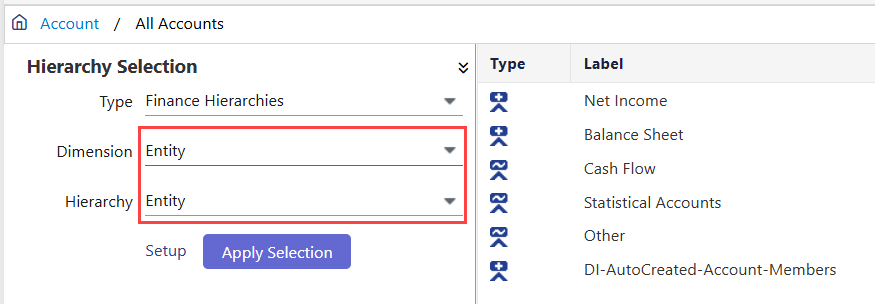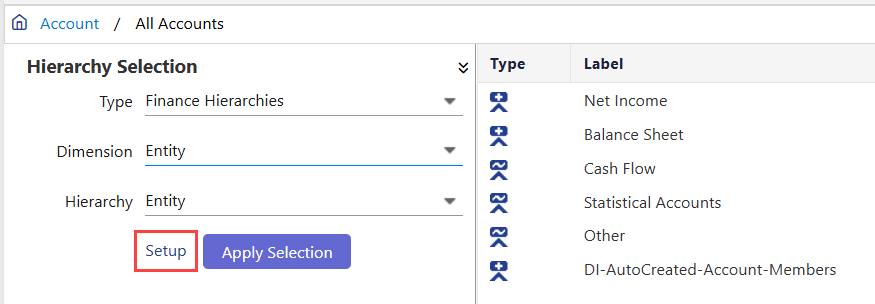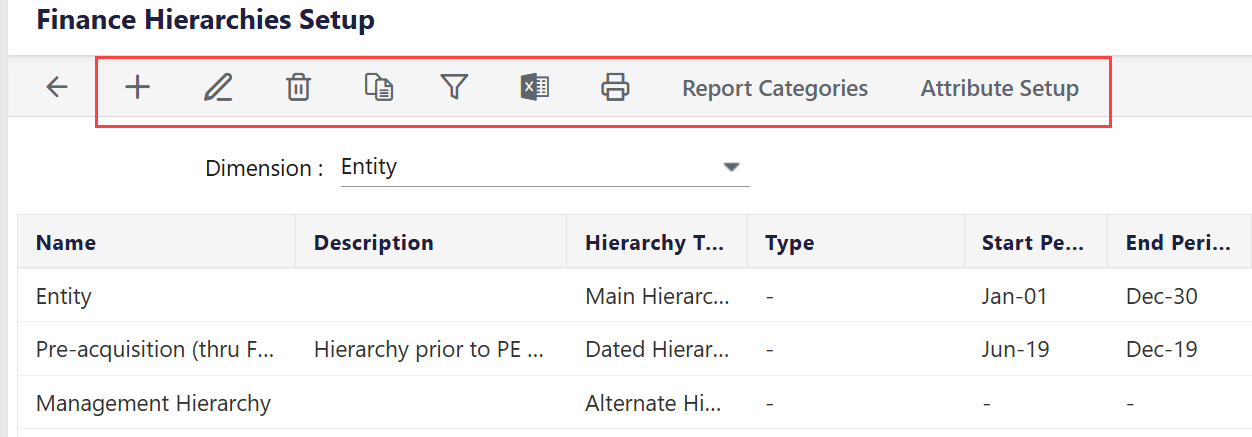- 2 Minutes to read
- Print
- DarkLight
- PDF
Creating and Managing Additional Finance Hierarchies
- 2 Minutes to read
- Print
- DarkLight
- PDF
Finance hierarchies categorize financial data into various segments and dimensions, facilitating more effective analysis. When the cube is initialized, the dimensions are defined for each financial segment. Navigate back to Maintenance > Hierarchy Management, and you will see the dimensions after selecting a Type in the Hierarchy Selection section on the left side of the Hierarchy Management interface.
The Hierarchy is defined when the hierarchy members are loaded into Planful for each dimension either using a Data Load Rule or added manually to the hierarchy in Hierarchy Management. For example, when a Company segment is created, all relevant company data can be loaded to build the corresponding financial hierarchy.
The Finance Hierarchies Setup area is where you categorize and structure financial data into specific segments and dimensions. While the main finance hierarchies are typically edited directly through the Hierarchy Management interface, the Finance Hierarchies Setup screen allows you to create additional hierarchies, such as alternate, attribute, and dated hierarchies, for more flexible and tailored reporting beyond the main structure.
- Alternate hierarchies provide alternative views of financial data, offering different summarization perspectives.
- Attribute hierarchies add granularity by focusing on specific characteristics of leaf-level dimension members within the main hierarchy.
- Dated hierarchies allow you to manage and track changes in organizational structures over time. This feature enables you to create new versions of hierarchies, capture snapshots of past versions, and generate reports based on different historical organizational structures.
These hierarchies enhance data management by breaking down complex financial data into more granular levels and providing historical context. They support scalability and adaptability, allowing the financial structure to evolve with organizational growth or changes, and ensuring that the system remains robust and responsive to both current and historical reporting needs.
- You must have Dated Hierarchies enabled on the Configuration Task page. Contact Planful Support to enable Dated Hierarchies in Configuration Tasks.
- While you can edit a hierarchy even after its members are in use (such as by moving members between rollups or adding new members), there are exceptions for Attribute Hierarchies:
- Editing is restricted to attribute hierarchies used in reporting. However, it is possible to "unmap" the members, make the necessary changes, and remap them to the hierarchy. Although this process can be cumbersome, it allows for editing when required.
How to Create Additional Finance Hierarchies?
To navigate to the Finance Hierarchies Setup screen, do the following:
- Navigate to Maintenance > Hierarchy > Hierarchy Management.
- Select the hierarchy type as Finance Hierarchies from the Type dropdown.

- Select the required Dimension and Hierarchy.

- Click Setup. The Finance Hierarchies Setup page appears.

Selections on the Finance Hierarchies Setup Area
- Add: Create a new additional hierarchy structure, such as an Attribute hierarchy, Alternate Setup, or Dated Setup, depending on your needs.
- Edit: Modify the selected hierarchy details, allowing you to update names, descriptions, or types.
- Delete: Remove the selected hierarchy from the list. Use this to delete configurations that are no longer needed.
- Copy: Create a duplicate copy of a selected hierarchy. For instance, if you want to replicate the Department Main hierarchy and save it as an Alternate hierarchy, you can do so. This allows you to modify the duplicate based on your specific reporting needs.
- Export as Excel: Export the hierarchies in Excel format.
- Print: Allows you to print the hierarchies.
- Report Categories: Report categories are assigned to dimensions for organization and reporting purposes. Click here to learn more.
- Attribute Setup: Attributes are used to report and aggregate dimension data based on traits. Before creating an Attribute Hierarchy, you'll define attributes. The attributes defined here are used in the Budget Entity Definition and reports. Click here to learn more about attribute setup.


